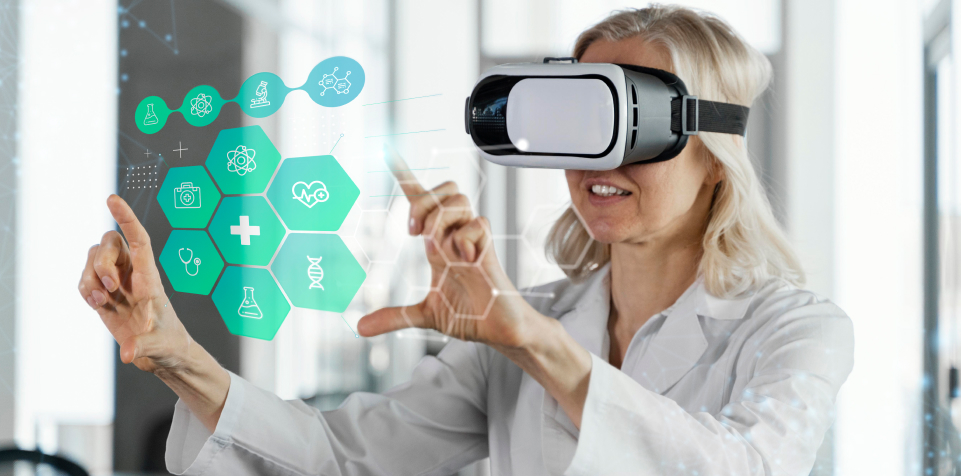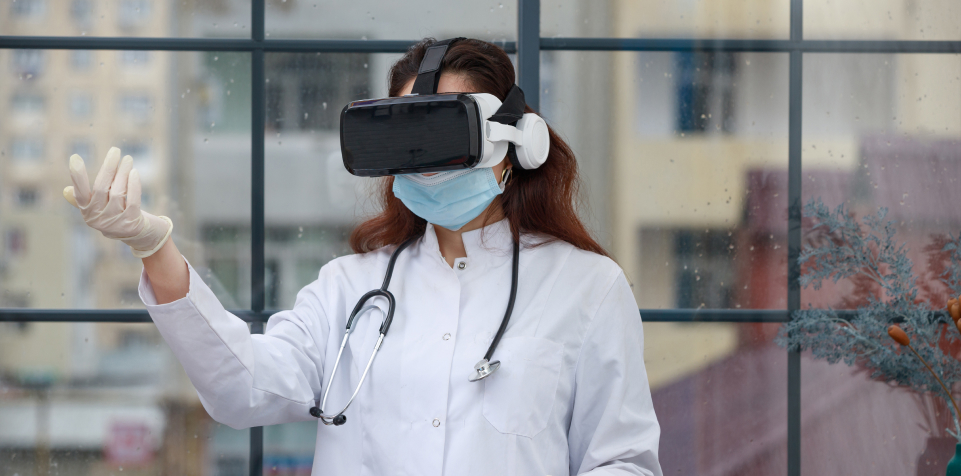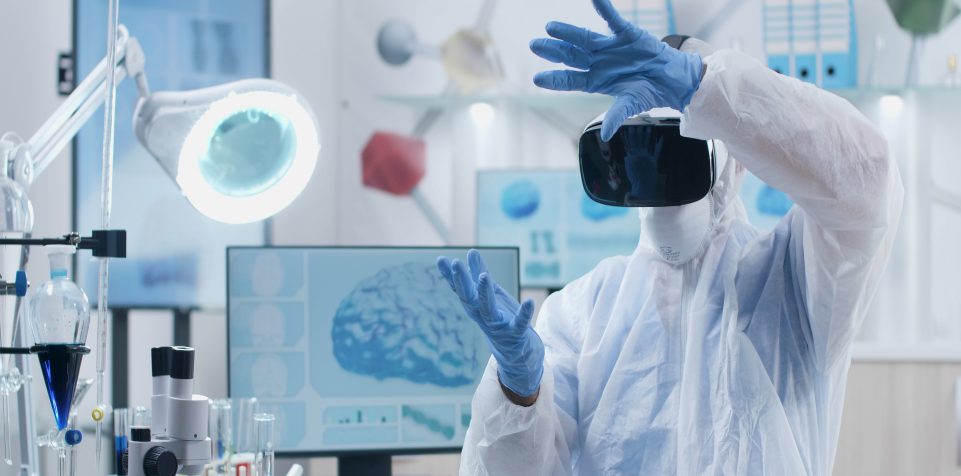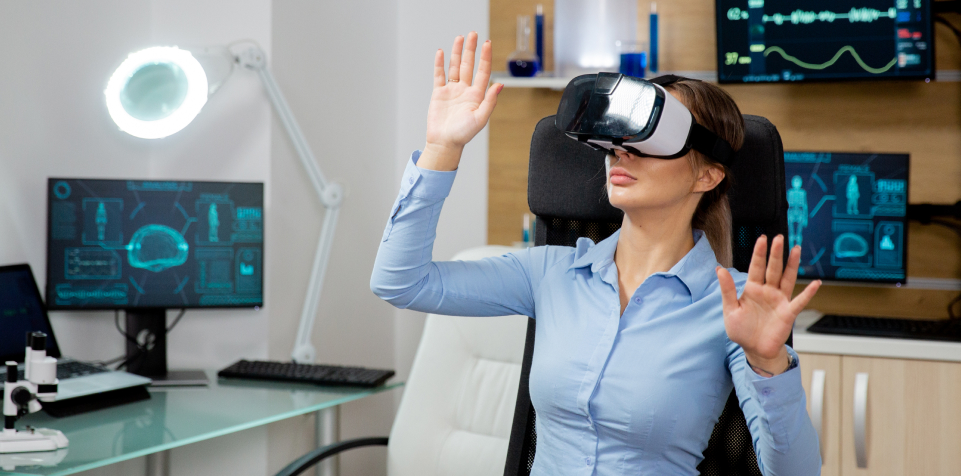Role of AR, VR, and MR in Reshaping the Healthcare Industry
August 8, 2023

he healthcare industry offers visionary thoughts and channels exponential growth for making the biggest contribution to human welfare. Being home to the largest working population in the world, the position of India as a global startup is rising fast. Offering the opportunity for superior experiences and outcomes and improved access to the world’s remotest parts, Augmented Reality, Virtual Reality, and Mixed Reality hold massive potential to strengthen our healthcare ecosystem.
AR (Augmented Reality) is the technology that superimposes the virtual elements in the real world to enhance contextual meaning, whereas VR (Virtual Reality) enables users to immerse in a virtual environment entirely and creates a completely stimulated environment. Mixed Reality, also known as “extended reality” and “hybrid reality” has the potential to alter every industry, and healthcare is no exception. A combination of AI, AR, and VR, MR is emerging as a tech in order to create experiences that can blend the experiences of real-life environments with digital elements.
As per a report by Research and Markets , in 2020, the MR market was valued at USD 376.1 million, and by 2026 is expected to reach USD 3,915.6 million with an anticipated CAGR of 41.8%. The global VR and AR industry in healthcare is predicted to grow quicker and reform in the next few years. A data consulting and analytics firm based in London, Global Data estimated that VR and AR markets will rise by around 25%. The contribution of India to this was projected to be approximately $550 million in 2020, and by 2023, it is projected to grow to $6.5 billion.
Today, with more than 2000 startup companies working on VR and AR technologies in this country, envisioning a refurbished healthcare landscape would be mindboggling in the upcoming years. These immersive visual technologies, along with XR technology in healthcare, are expected to be a disruptive and permanent force in the future that enhances both practitioner and patient safety while fueling innovation. Let’s have a look at how AR, VR, and MR are reshaping the future of healthcare.
AR, VR, and MR: Reshaping complex healthcare problems

The impression of AR and VR in healthcare offers varied applications in healthcare services allowing stakeholders to boost the overall experience for providers and patients alike. The introduction of VR and AR technologies such as Magic Leap and Microsoft HoloLens has unlocked the doors to numerous opportunities in the healthcare industry. Mixed realities provide infinite possibilities in medical diagnosis, rehabilitation, treatments, surgeries, and training, making it extremely accurate and detailed.
Instant/ real-time diagnosis
The healthcare industry is using VR for immersive visualization. Various other usages of VR include supporting medical practitioners to gain a multi-dimensional sight of medical scans. They can get a thorough understanding of the patient’s medical condition. The incorporation of AR in healthcare diagnostics is helping the industry with tools for real-time visualizations by combining its development with MR.
MR headsets can record the patient history verbally that is communicated by medical professionals, that anyone can access, including the nursing staff. Moreover, these headsets can analyze data and give reports to doctors in real time, thus eliminating the requirement to go through physical reports manually, making diagnosis more accurate and faster. MR glasses can link the digital images on the body of a patient and help medical practitioners in conducting real-time analysis.
Enhanced image-guided Surgery

MR develops personalized 3D models for each patient and visualizes the interior anatomy in a completely immersive environment, thus helping pre-operative simulations. Wearable MR devices, along with new emerging imaging technologies, can help in complex surgical procedures greatly, like reconstructive surgeries, where holographic overlays aid surgeons in viewing the bone better and identifying the path of blood vessels. As per Grand View Research, the global MR in healthcare market size in 2019 was valued at USD 54.2 million and is expected to increase at a CAGR of 48.7% from 2020 to 2027.
Medical training
In recent years, mixed realities have seen popularity in academics, where they can act as an aid for teachers in teaching various techniques and subjects. Students also hone their skills before they perform surgeries on patients. Also, doctors use MR for rehearsing complicated surgeries, thus saving their valuable time during the procedure, increasing their success rate.
The first AR system for surgery adds a 3D representation that helps the surgeon view the tissue, skin, and anatomy of the patient via his beam vision. A holographic AR platform has been developed by a digital healthcare company that provides surgeons with visualizations and patient information during surgery. This platform lets surgeons review 3D images of the specific anatomy to ensure the success of the surgical procedure. Augmented Reality, virtual reality, surgery, treatment, well-being, and self-care improve several aspects of healthcare.
Accurate disease and risk diagnosis
AR-based applications benefit doctors to detect, avoid, and treat numerous diseases with an improved prognosis. It can visualize information collected from several sensors into one unified interface for determining specific causes for a patient’s condition. Also, it allows doctors to monitor organs, lesions, veins, and other structures without invasive procedures.
Empowering healthcare professionals
MR empowers healthcare professionals to renew and rethink the healthcare industry by speeding up the process of diagnostics and streamlining care time, thus improving outcomes and enabling personalized experiences for patients. The surge in the clinical research shows positive results of mixed-effects treatment for patients generates positive impacts on healthcare professionals and patients as is anticipated to boost the market growth. The increased studies and research activities that signal the use of MR in certain diseases like mental health and pain management will increase the growth of sales in the forecast period.
Capabilities of Telemedicine
As more patients depend on virtual visits, telemedicine has become increasingly crucial, and VR has taken this procedure to the next level. In healthcare VR allows doctors to accomplish sensory tests on patients with monitor impairments like muscle weakness in patients suffering from stroke. Companies have been incorporating VR into telemedicine, XRHealth being the prime example.
Improving patient experience
Establishing a patient-doctor relationship is a vital aspect that aids in building trust between them. When communication is effective, concise, and clear, patients can trust doctors. MR helps in establishing it in a much more immersive manner. It assists doctors in explaining things in detail to patients for better understanding and clarity. In the healthcare sector, MR improves surgical accuracy and minimizes response time. Eventually, this leads to smooth treatment and also a satisfying experience for the patients.
Hesitance in implementing VR, AR, and MR

MR can be used in various situations in healthcare, from acute care units to home care. While MR technology is projected to increase patient satisfaction and outcomes and save costs, healthcare professionals have been encountering various challenges when they prepare to implement it. High investment costs, the lack of suitable skills among the medical practitioners, fear of data loss, creating a secure environment, defining reimbursement schemes, and establishing interoperability with the existing systems will likely stifle the market growth during the assessment period.
Also, as the integration of VR and AR has advanced significantly, certain challenges have been deterring its adoption on a massive scale in health care. Implementing VR and AR systems is expensive as the development of these programs needs top-quality graphics cards, computers, and hardware. Also, there must be a precise tracking system, specialized accessories and high-resolution displays. The execution process is slow, mostly because of the high cost incurred in its design and implementation. Compact educational constraints and face-to-face communication hinder VR and AR applications in health care. With these technologies through all-encompassing information going digital, the risk involved with data breaches surges.
In conclusion,
Over the anticipated period, despite these challenges, progresses in regulatory policies are predicted to ease the adoption of the technology. Factors such as speedy advancement in sensor technology, growing increased user acceptance, MR applications in medical treatment, and amplified workload of healthcare workers are pushing the adoption of MR in the global healthcare market. Also, the benefits of MR systems, like reduced human effort, better service quality, and improved operational efficiency, are estimated to boost the rise of mixed reality in the healthcare sector.
As per the estimation of Statista report, in 2025, the global MR market will surge by around 3.7 billion U.S. dollars, and the healthcare sector will grip the majority. It will not be shocking to see clinics and hospitals amplifying the use of AR, VR, and MR technologies in their clinical activities. So, it can be said that with the apparent limitations, the healthcare industry in India and across the globe is amplifying the integration of VR and AR and will advance in discovering the best solutions for both specialists and patients, thus making the health system work best for all.
Share on







